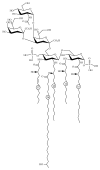Natural Products with Toll-Like Receptor 4 Antagonist Activity
- PMID: 29686833
- PMCID: PMC5852877
- DOI: 10.1155/2018/2859135
Natural Products with Toll-Like Receptor 4 Antagonist Activity
Abstract
Toll-Like Receptors (TLRs) are the innate immunity receptors that play an activating role when interacting with molecules released by bacteria and viruses (PAMPs, pathogen-associated molecular patterns) or with molecules released by injured cells and tissues (DAMPs, danger-associated molecular patterns). TLR triggering leads to the induction of proinflammatory cytokines and chemokines, driving the activation of both innate and adaptive immunity. In particular, Toll-Like Receptor 4 (TLR4) has been described to be involved in the inflammatory processes observed in several pathologies (such as ischemia/reperfusion injury, neuropathic pain, neurodegenerative diseases, and cancer). Molecules obtained by natural sources have been discovered to exert an anti-inflammatory action by targeting TLR4 activation pathways. This review focuses on TLR4 antagonists obtained from bacteria, cyanobacteria, and plants.
Figures





References
Publication types
LinkOut - more resources
Full Text Sources
Other Literature Sources

